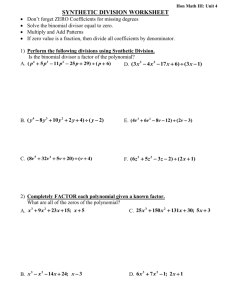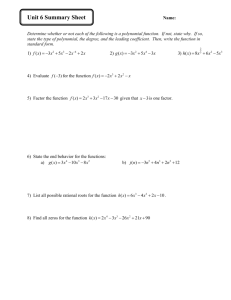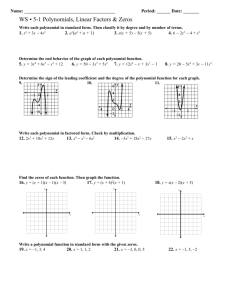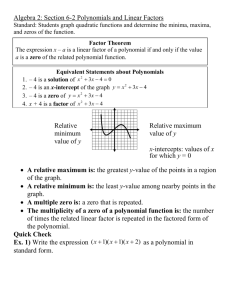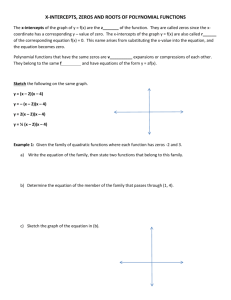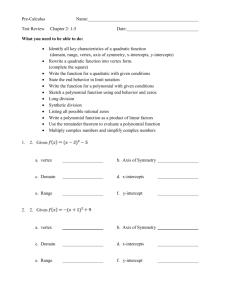chapter 2: polynomial and rational functions
advertisement
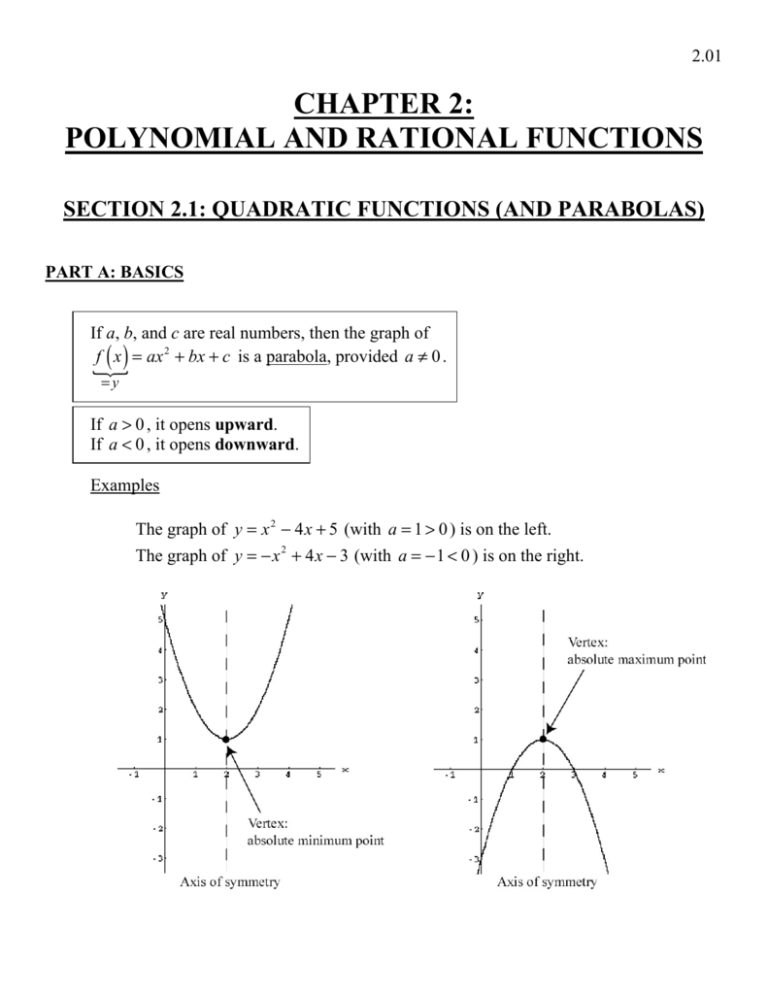
2.01 CHAPTER 2: POLYNOMIAL AND RATIONAL FUNCTIONS SECTION 2.1: QUADRATIC FUNCTIONS (AND PARABOLAS) PART A: BASICS If a, b, and c are real numbers, then the graph of f x = ax 2 + bx + c is a parabola, provided a ≠ 0 . () =y If a > 0 , it opens upward. If a < 0 , it opens downward. Examples The graph of y = x 2 − 4x + 5 (with a = 1 > 0 ) is on the left. The graph of y = −x 2 + 4x − 3 (with a = −1 < 0 ) is on the right. 2.02 PART B: FINDING THE VERTEX AND THE AXIS OF SYMMETRY (METHOD 1) ( ) The vertex of the parabola [with equation] y = ax 2 + bx + c is h, k , where: b , and 2a y-coordinate = k = f h . x-coordinate = h = − () The axis of symmetry, which is the vertical line containing the vertex, has equation x = h . (Does the formula for h look familiar? We will discuss this later.) Example Find the vertex of the parabola y = x 2 − 6x + 5 . What is its axis of symmetry? Solution ( ) The vertex is h, k , where: h=− b −6 =− = 3 , and 2a 21 () () = ( 3) − 6 ( 3) + 5 k= f 3 2 = −4 ( ) The vertex is 3, − 4 . The axis of symmetry has equation x = 3 . Since a = 1 > 0 , we know the parabola opens upward. Together with the vertex, we can do a basic sketch of the parabola. 2.03 PART C: FINDING MORE POINTS () “Same” Example: y = x 2 − 6x + 5 , or f x = x 2 − 6x + 5 Find the y-intercept. Plug in 0 for x. Solve for y. In other words, find f 0 . () The y-intercept is 5. (If the parabola is given by y = ax 2 + bx + c , then c, the constant term, is the y-intercept. Remember that b was the y-intercept for the line given by y = mx + b .) Find the x-intercept(s), if any. Plug in 0 for y. Solve for x (only take real solutions). In other words, find the real zeros of f x = x 2 − 6x + 5 . () 0 = x 2 − 6x + 5 ( )( ) 0 = x −5 x −1 x = 5 or x = 1 The x-intercepts are 1 and 5. () Note: Observe that f x = x 2 + 1 has no real zeros and, therefore, has no xintercepts on its graph. You can find other points using the Point-Plotting Method (Notes 1.27). Symmetry helps! 2.04 PART D: PARABOLAS AND SYMMETRY “Same” Example () Sketch the graph of y = x 2 − 6x + 5 , or f x = x 2 − 6x + 5 . Clearly indicate: 1) The vertex 2) Which way the parabola opens 3) Any intercepts Make sure your parabola is symmetric about the axis of symmetry. Solution Point A is the vertex. Points B and C are the x-intercepts. Point D is the y-intercept. We get the “bonus” Point E by exploiting symmetry. 2.05 Observe that the x-intercepts are symmetric about the axis of symmetry. This makes sense, because the zeros of f are given by the QF: −b ± b2 − 4ac x= 2a The average of these zeros is − axis of symmetry. b , which is the x-coordinate for the vertex and the 2a () Technical Note: If the zeros of a quadratic f x are imaginary, then they must have the b b . The axis of symmetry will still be x = − . There 2a 2a will be no x-intercepts, however. same real part, which will be − Technical Note: The x-intercept on the right (if any) does not always correspond to the “+” case in the QF. Remember, a can be negative. 2.06 PART E: STANDARD FORM FOR THE EQUATION OF A PARABOLA; FINDING THE VERTEX AND THE AXIS OF SYMMETRY (METHOD 2) ( ) , but its vertex is ( h, k ) . 2 The graph of y = a x − h + k is a parabola that has the same shape as the parabola y = ax 2 Remember translations from Section 1.6. The parabola y = ax 2 , which has vertex 0, 0 , is shifted h units horizontally and ( ) k units vertically to obtain the new parabola. ( ) 2 If y = a x − h + k is written out in the form y = ax 2 + bx + c , then the “a”s are, in fact, the same. Example ( ) 2 Rewrite y = 3x 2 + 12x + 11 in the form y = a x − h + k , and find the vertex. Solution Step 1: Group the quadratic and linear terms and factor out a from the group. ( ) y = 3( x + 4x ) + 11 y = 3x 2 + 12x + 11 2 Step 2: Complete the Square (CTS) and Compensate. Take the coefficient of x inside the (), halve it, and square the result. This is the number we add inside the (). Half of 4 is 2, and the square of 2 is 4. ( ) () y = 3 x 2 + 4x + 4 + 11 − 3 4 PST 2.07 Step 3: Factor our Perfect Square Trinomial (PST) as the square of a binomial, and simplify. ( ) 2 y = 3 x+2 −1 ( ) The vertex is − 2, − 1 . Warning: Don’t forget the first "− ." Remember that the x-coordinate of the vertex must make x + 2 equal to 0. This makes sense, because the vertex is ( ) an “extreme” point, and 0 is as “extreme” a square can get. The axis of symmetry is x = − 2 . a = 3 > 0 , so the parabola opens upward. ( ) 2 Note: A key advantage that the form y = a x − h + k has over the form y = ax 2 + bx + c is that the vertex is easier to find using the first form. Also, x-intercepts (but not the y-intercept) may be easier to find. 2.08 PART F: GIVEN SOME POINTS, FIND THE PARABOLA PASSING THROUGH THEM Two distinct points determine a line. Three noncollinear points (i.e., points that do not lie on a straight line) determine a parabola. If we know the vertex and one other point on the parabola, then we can get a third point automatically by exploiting symmetry. Technical Note: If you successively plug in the coordinates of the three points into the form y = ax 2 + bx + c , you will obtain a system of three linear equations in three unknowns (a, b, and c). Have fun! ( ) 2 If we know the vertex, then the form y = a x − h + k makes matters easier for us. Example ( ) Find an equation for the parabola that has vertex 4, 2 and that contains the point (1, 29) . Solution Using the vertex: ( ) y = a ( x − 4) 2 y=a x−h +k 2 ( +2 ) Plug in x = 1, y = 29 and solve for a: ( ) 2 29 = a 1 − 4 + 2 29 = 9a + 2 27 = 9a a=3 2.09 An equation for the parabola is: ( ) 2 y=3 x−4 +2 Here’s a graph: Note: In applications, you can think of this as “modeling a quadratic function.” We will see parabolas again in Section 10.2. 2.10 SECTION 2.2: POLYNOMIAL FUNCTIONS OF HIGHER DEGREE PART A: INFINITY The Harper Collins Dictionary of Mathematics defines infinity, denoted by ∞ , as “a value greater than any computable value.” The term “value” may be questionable! Likewise, negative infinity, denoted by − ∞ , is a value lesser than any computable value. Warning: ∞ and − ∞ are not numbers. They are more conceptual. We sometimes use the idea of a “point at infinity” in graphical settings. PART B: LIMITS The concept of a limit is arguably the key foundation of calculus. (It is the key topic of Chapter 2 in the Calculus I: Math 150 textbook at Mesa.) Example () () “ lim f x = − ∞ ” is read “the limit of f x as x approaches infinity is negative x→∞ infinity.” It can be rewritten as: () () “ f x → − ∞ as x → ∞ ,” which is read “ f x approaches negative infinity as x approaches infinity.” The Examples in Part C will help us understand these ideas! 2.11 PART C: BOWLS AND SNAKES Let a represent a nonzero real number. Recall that the graphs for ax 2 , ax 4 , ax 6 , ax 8 , etc. are “bowls.” If a > 0 , then the bowls open upward. If a < 0 , then the bowls open downward. Examples () () The graph of f x = x 2 is on the left, and the graph of g x = −x 2 is on the right. () lim f ( x ) = ∞ x→− ∞ lim f x = ∞ x→∞ () lim g ( x ) = − ∞ x→− ∞ lim g x = − ∞ x→∞ 2.12 Let a represent a nonzero real number. Recall that the graphs for ax 3 , ax 5 , ax 7 , ax 9 , etc. are “snakes.” If a > 0 , then the snakes rise from left to right. If a < 0 , then the snakes fall from left to right. Examples () () The graph of f x = x 3 is on the left, and the graph of g x = −x 3 is on the right. () lim f ( x ) = − ∞ x→− ∞ lim f x = ∞ x→∞ () lim g ( x ) = ∞ x→− ∞ lim g x = − ∞ x→∞ 2.13 PART D: THE “ZOOM OUT” DOMINANCE PROPERTY Example () The graph of f x = 4x 3 − 5x 2 − 7x + 2 is below. () Observe that 4x 3 is the leading (i.e., highest-degree) term of f x . If we “zoom out,” we see that the graph looks similar to the graph for 4x 3 (in blue below). 2.14 () To determine the “long run” behavior of the graph of f x as x → ∞ and as x → − ∞ , it is sufficient to consider the graph for the leading term. (See p.123.) () Even if we don’t know the graph of f x , we do know that the graph for 4x 3 is a rising snake (in particular, a “stretched” version of the graph for x 3 ). We can conclude that: () lim f ( x ) = − ∞ x→− ∞ lim f x = ∞ x→∞ “Zoom Out” Dominance Property of Leading Terms () The leading term of a polynomial f x increasingly dominates the other terms and increasingly determines the shape of the graph “in the long run” (as x → ∞ and as x → − ∞ ) The lower-degree terms can put up a fight for part of the graph, and the struggle can lead to relative maximum and minimum points (“turning points (TPs)”) along the graph. In the long run, however, the leading term dominates. In Calculus: You will locate these turning points. () ( ) Note: The graph of h x = x + 1 translation of the x 4 bowl graph. 4 is on p.122. It’s easiest to look at its graph as a 2.15 PART E: TURNING POINTS (TPs) () The graph for a nonconstant n th -degree polynomial f x can have no more than n − 1 TPs. In Calculus: You will see why this is true. Only high-degree polynomial functions can have very wavy graphs. Even-Degree Case If we trace a bowl graph from left to right, it “goes back to where it came from.” In terms of “long run” behaviors, bowls “shoot off” in the same general direction: up or down. () () Using notation, lim f x and lim f x are either both ∞ (as in the left graph) x→∞ x→− ∞ or both − ∞ (as in the right graph). If we apply the “Zoom Out” Dominance Property, we see that this is true for all nonconstant even-degree f x . It must then be true that: () () The graph of a nonconstant even-degree polynomial f x must have an odd number of TPs. 2.16 Odd-Degree Case If we trace a snake graph from left to right, it “runs away from where it came from.” In terms of “long run” behaviors, snakes “shoot off” in different directions: up and down. () () Using notation, either lim f x or lim f x must be ∞ , and the other must x→∞ be − ∞ . x→− ∞ If we apply the “Zoom Out” Dominance Property, we see that this is true for all odd-degree f x . It must then be true that: () () The graph of an odd-degree polynomial f x must have an even number of TPs. Another consequence: () An odd-degree polynomial f x must have at least one real zero. After all, its graph must have an x-intercept! 2.17 Example () How many TPs can the graph of a 3rd-degree polynomial f x have? Solution The degree is odd, so there must be an even number of TPs. The degree is 3, so # of TPs ≤ 2 . ( ) Answer: The graph can have either 0 or 2 TPs. Observe that the graph for x 3 on the left has 0 TPs, and the graph for 4x 3 − 5x 2 − 7x + 2 on the right has 2 TPs. 2.18 Example () How many TPs can the graph of a 6th-degree polynomial f x have? Solution The degree is even, so there must be an odd number of TPs. The degree is 6, so # of TPs ≤ 5 . ( ) Answer: The graph can have 1, 3, or 5 TPs. Observe that the graph for x 6 on the left has 1 TP, and the graph for x 6 − 6x 5 + 9x 4 + 8x 3 − 24x 2 + 5 on the right has 3 TPs. Tip Observe that, in both previous Examples, you start with n − 1 and count down by twos. Stop before you reach negative numbers. 2.19 PART F: ZEROS AND THE FACTOR THEOREM () An n th -degree polynomial f x can have no more than n real zeros. Factor Theorem () If f x is a nonzero polynomial and k is a real number, then ( ) () k is a zero of f ⇔ x − k is a factor of f x . Example Find a 3rd-degree polynomial function that only has 4 and –1 as its zeros. Solution You may use anything of the form: ( a x−4 ) ( x + 1) 2 or ( )( ) 2 a x − 4 x +1 , where a, which turns out to be the leading coefficient of the expanded form, is any nonzero real number. For example, we can use: () ( f x = x−4 ) ( x + 1) 2 = x 3 − 7x 2 + 8x + 16 Its graph has 4 and –1 as its only x-intercepts: 2.20 ( ) Because the exponent on x − 4 is 2, we say that 2 is the multiplicity of the zero “4.” The x-intercept at 4 is a TP, because the multiplicity is even (and positive). Technical Note: If we “zoom in” onto the x-intercept at 4, the graph appears ( to be almost symmetric about the line x = 4 , due to the x − 4 ( ) ) 2 factor and the fact that, on a small interval containing 4, x + 1 is almost a constant, 5. PART G: THE INTERMEDIATE VALUE THEOREM, AND THE BISECTION METHOD FOR APPROXIMATING ZEROS A dirty secret of mathematics is that we often have to use computer algorithms to help us approximate zeros of functions. While we do have (uglier) analogs of the Quadratic Formula for 3rd- and 4th-degree polynomial functions, it has actually been proven that there is no such formula for 5th- and higher-degree polynomial functions. Polynomial functions are examples of continuous functions, whose graphs are unbroken in any way. The Bisection Method for Approximating a Zero of a Continuous Function ( ) ( ) Try to find x-values a1 and b1 such that f a1 and f b1 have opposite signs. According to the Intermediate Value Theorem from Calculus, there must be a zero of f somewhere between a1 and b1 . If a1 < b1 , then we can call ⎡⎣ a1 , b1 ⎤⎦ our “search interval.” For example, our search interval below is ⎡⎣ 2, 8 ⎤⎦ . 2.21 ( ) ( ) If either f a1 or f b1 is 0, then we have a zero of f , and we can either stop or try to approximate another zero. If neither is 0, then we can take the midpoint of the search interval and find out what sign f is there (in red below). We can then shrink the search interval (in purple below) and repeat the process. We repeat the process until we either find a zero, or until the search interval is small enough so that we can be happy with simply taking the midpoint of the interval as our approximation. A key drawback to the Bisection Method is that, unless we manage to find n distinct real zeros of an n th -degree polynomial f x , we may need other () techniques to be sure that we have found all of the real zeros, if we are looking for all of them. 2.22 PART H: A CHECKLIST FOR GRAPHING POLYNOMIAL FUNCTIONS (BONUS TOPIC) (You should know how to accurately graph constant, linear, and quadratic functions already.) Remember that graphs of polynomial functions have no breaks, holes, cusps, or sharp corners (such as for x ). 1) Find the y-intercept. () It’s the constant term of f x in standard form. 2) Find the x-intercept(s), if any. () In other words, find the real zeros of f x . Approximations may be necessary. We will discuss this further in Section 2.5. 3) Exploit symmetry, if possible. Is f even? Odd? 4) Use the “Zoom Out” Dominance Property. This determines the “long-run” behavior of the graph as x → ∞ and as x → − ∞ . The book uses the “Leading Coefficient Test,” which is essentially the same thing. 2.23 () () 5) Find where f x > 0 and where f x < 0 . See p.126 for the Test Interval (or “Window”) Method. A continuous function can only change sign at its zeros, so we know everything about the sign of f everywhere if we locate all of the zeros, break the x-axis (i.e., the real number line) into “test intervals” or “windows” by using the zeros as fence posts, and evaluate f at an x-value in each of the windows. The sign of f at a “test” x-value must be the sign of f all throughout the corresponding window. () has an x-intercept where f ( x ) = 0 . lies below the x-axis where f ( x ) < 0 . The graph of f lies above the x-axis where f x > 0 . The graph of f The graph of f Example () ( The graph below of f x = x − 4 ) ( x + 1) , 2 or x 3 − 7x 2 + 8x + 16 appeared in Notes 2.19. () The signs of f x are in red below. Window separators are in blue (they are not asymptotes). 2.24 If a zero of f has even multiplicity, then the graph has a TP there. If it has odd multiplicity, then it does not. You can avoid using the Test Interval (or “Window”) Method if you know the complete factorization of f x over the reals and use the () “Zoom Out” Property. 6) Do point-plotting. Do this as a last resort, or if you want a more accurate graph. In Calculus: You will locate turning points (which are extremely helpful in drawing an accurate graph) and inflection points (points where the graph changes curvature from concave down to concave up or vice-versa). If you can locate all the turning points (if any), then you can find the range of the function graphically. (We know the domain of a polynomial function is always R.) Think About It: What is the range of any odd-degree polynomial function? Can an evendegree polynomial function have the same range? 2.25 SECTION 2.3: LONG AND SYNTHETIC POLYNOMIAL DIVISION PART A: LONG DIVISION Ancient Example with Integers 4 2 9 −8 We can say: 1 9 1 = 2+ 4 4 By multiplying both sides by 4, this can be rewritten as: 9 = 4⋅2 +1 In general: dividend, f divisor, d = ( quotient, q ) + ( remainder, r ) d where either: r = 0 (in which case d divides evenly into f ), or r is a positive proper fraction: i.e., 0 < r < d d Technical Note: We assume f and d are positive integers, and q and r are nonnegative integers. f is improper: i.e., f ≥ d . d Otherwise, there is no point in dividing this way. Technical Note: We typically assume Technical Note: Given f and d, q and r are unique by the Division Algorithm (really, it’s a theorem). By multiplying both sides by d, f r = q + can be rewritten as: d d f = d ⋅q + r 2.26 ( ) so that we get: d ( x) r ( x) q ( x) + d ( x) Now, we will perform polynomial division on () d ( x) f x = f x where either: () () () r ( x) is a proper rational expression: i.e., deg ( r ( x )) < deg ( d ( x )) d ( x) r x = 0 , in which case d x divides evenly into f x , or () () () Technical Note: We assume f x and d x are nonzero polynomials, and q x () and r x are polynomials. Technical Note: We assume ( ) is improper; i.e., deg f x ≥ deg d x . ( ( )) ( ( )) d ( x) f x Otherwise, there is no point in dividing. () () () () Technical Note: Given f x and d x , q x and r x are unique by the Division Algorithm (really, it’s a theorem). () By multiplying both sides by d x , () d ( x) f x () () = q x + () d ( x) r x () () can be rewritten as: () f x = d x ⋅q x + r x 2.27 Example − 5 + 3x 2 + 6x 3 Use Long Division to divide: 1 + 3x 2 Solution Warning: First, write the N and the D in descending powers of x. Warning: Insert “missing term placeholders” in the N (and perhaps even the D) with “0” coefficients. This helps you avoid errors. We get: 6x 3 + 3x 2 + 0x − 5 3x 2 + 0x + 1 Let’s begin the Long Division: 3x 2 + 0x + 1 6x 3 + 3x 2 + 0x − 5 The steps are similar to those for 4 9. Think: How many “times” does the leading term of the divisor ( 3x 2 ) “go into” the leading term of the dividend ( 6x 3 )? We get: 6x 3 = 2x , which goes into the quotient. 3x 2 2x 3x 2 + 0x + 1 6x 3 + 3x 2 + 0x − 5 Multiply the 2x by the divisor and write the product on the next line. Warning: Line up like terms to avoid confusion! 2x 3x 2 + 0x + 1 6x 3 + 3x 2 + 0x − 5 6x 3 + 0x 2 + 2x 2.28 Warning: We must subtract this product from the dividend. People have a much easier time adding than subtracting, so let’s flip the sign on each term of the product, and add the result to the dividend. To avoid errors, we will cross out our product and do the sign flips on a separate line before adding. Warning: Don’t forget to bring down the − 5 . We now treat the expression in blue above as our new dividend. Repeat the process. 2.29 We can now stop the process, because the degree of the new dividend is less than the degree of the divisor. The degree of − 2x − 6 is 1, which is less than the degree of 3x 2 + 0x + 1 , which is 2. This guarantees that the fraction in our answer is a proper rational expression. () Our answer is of the form: q x + 2x + 1 + () d ( x) r x − 2x − 6 3x 2 + 1 () If the leading coefficient of r x is negative, then we factor a −1 out of it. Answer: 2x + 1 - 2x + 6 3x 2 + 1 Warning: Remember to flip every sign in the numerator. Warning: If the N and the D of our fraction have any common factors aside from ±1, they must be canceled out. Our fraction here is simplified as is. 2.30 PART B: SYNTHETIC DIVISION There’s a great short cut if the divisor is of the form x − k . Example 2x 3 − 3x + 5 Use Synthetic Division to divide: . x+3 Solution The divisor is x + 3 , so k = − 3 . ( ) Think: x + 3 = x − − 3 . We will put − 3 in a half-box in the upper left of the table below. Make sure the N is written in standard form. Write the coefficients in order along the first row of the table. Write a “placeholder 0” if a term is missing. Bring down the first coefficient, the “2.” The ↓ arrow tells us to add down the column and write the sum in the third row. The arrow tells us to multiply the blue number by k (here, − 3 ) and write the product one column to the right in the second row. Circle the lower right number. 2.31 Since we are dividing a 3rd-degree dividend by a 1st-degree divisor, our answer begins with a 2nd-degree term. The third (blue) row gives the coefficients of our quotient in descending powers of x. The circled number is our remainder, which we put over our divisor and factor out a −1 if appropriate. Note: The remainder must be a constant, because the divisor is linear. Answer: 2x 2 - 6x + 15 - 40 x+3 Related Example () f ( x) = d ( x) ⋅ q ( x) + Express f x = 2x 3 − 3x + 5 in the following form: () r , where the divisor d x = x + 3 . Solution We can work from our previous Answer. Multiply both sides by the divisor: 2x 3 − 3x + 5 40 = 2x 2 - 6x + 15 x+3 x+3 3 2 2x − 3x + 5 = x + 3 ⋅ 2x - 6x + 15 − 40 ( )( ) Note: Synthetic Division works even if k = 0 . What happens? 2.32 PART C: REMAINDER THEOREM Remainder Theorem () If we are dividing a polynomial f x by x − k , and if r is the remainder, then () f k = r. In our previous Examples, we get the following fact as a bonus. Synthetic Division therefore provides an efficient means of evaluating polynomial functions. (It may be much better than straight calculator button-pushing when dealing with polynomials of high degree.) We could have done the work in Part B if we had wanted to evaluate f − 3 , where f x = 2x 3 − 3x + 5 . ( ) () Warning: Do not flip the sign of − 3 when writing it in the half-box. People get the “sign flip” idea when they work with polynomial division. Technical Note: See the short Proof on p.192. 2.33 PART D: ZEROS, FACTORING, AND DIVISION Recall from Section 2.2: Factor Theorem () If f x is a nonzero polynomial and k is a real number, then ( ) () k is a zero of f ⇔ x − k is a factor of f x . Technical Note: The Proof on p.192 uses the Remainder Theorem to prove this. What happens if either Long or Synthetic polynomial division gives us a 0 remainder? Then, we can at least partially factor f x . () Example () f ( x ) in Section 2.2. Show that 2 is a zero of f x = 4x 3 − 5x 2 − 7x + 2 . Note: We saw this Note: In Section 2.5, we will discuss a trick for finding such a zero. () Factor f x completely, and find all of its real zeros. Solution We will use Synthetic Division to show that 2 is a zero: () By the Remainder Theorem, f 2 = 0 , and so 2 is a zero. 2.34 ( ) () By the Factor Theorem, x − 2 must be a factor of f x . Technical Note: This can be seen from the form f x = d x ⋅ q x + r . Since r = 0 when d x = x − 2 , we have: () () () () () ( ) () where q ( x ) is some (here, quadratic) polynomial. f x = x − 2 ⋅q x , () We can find q x , the other (quadratic) factor, by using the last row of the table. )( () ( ) f x = x − 2 ⋅ 4x 2 + 3x − 1 () Factor q x completely over the reals: ( ) ( )( )( f x = x - 2 4x -1 x + 1 ) () The zeros of f x are the zeros of these factors: 2, 1 , -1 4 () Below is a graph of f x = 4x 3 − 5x 2 − 7x + 2 . Where are the x-intercepts? 2.35 SECTION 2.4: COMPLEX NUMBERS Let a, b, c, and d represent real numbers. PART A: COMPLEX NUMBERS i, the Imaginary Unit We define: i = −1 . i 2 = −1 ( ) If c is a positive real number c ∈R + , then −c = i c. Note: We often prefer writing i c , as opposed to ci , because we don’t want to be confused about what is included in the radicand. Examples −15 = i 15 −16 = i 16 = 4i −18 = i 18 = i 9 ⋅ 2 = 3i 2 Here, we used the fact that 9 is the largest perfect square that divides 18 evenly. The 9 “comes out” of the square root radical as Standard Form for a Complex Number ( ) a + bi , where a and b are real numbers a, b ∈R . a is the real part; b or bi is the imaginary part. C is the set of all complex numbers, which includes all real numbers. In other words, R ⊆ C . 9 , or 3. 2.36 Examples 2, 3i, and 2 + 3i are all complex numbers. 2 is also a real number. 3i is called a pure imaginary number, because a = 0 and b ≠ 0 here. 2 + 3i is called an imaginary number, because it is a nonreal complex number. PART B: THE COMPLEX PLANE The real number line (below) exhibits a linear ordering of the real numbers. In other words, if c and d are real numbers, then exactly one of the following must be true: c < d , c > d , or c = d . The complex plane (below) exhibits no such linear ordering of the complex numbers. We plot the number a + bi as the point a, b . ( ) 2.37 PART C: POWERS OF i ( ) = ( −1) 0 =1 i4 = i2 i1 =i i 5 = i 4i i2 = −1 i =i i i ( ) i = i i = −1 i = − i 3 2 6 2 2 =1 ( )( ) = i = (1) ( −1) = −1 = (1) ( − i ) = − i = 1 i 4 2 i 7 = i 4i 3 … Technical Note: In general, it is true that when a complex number is multiplied by i, the corresponding point in the complex plane is rotated 90 counterclockwise about the origin. i n = i remainder when n is divided by 4 ( n ∈Z ) + Know the first column of the table at the top of this page! Examples: Simplify the following expressions: i 100 = i 0 = 1 . Note that 100 is a multiple of 4. i 83 = i 3 = − i 2.38 PART D: ADDING, SUBTRACTING, AND MULTIPLYING COMPLEX NUMBERS Steps Step 1: Simplify all radicals. Step 2: Think of i as x. Add, subtract, and multiply as usual. Warning: However, simplify all powers of i (except i, itself). ( ) Step 3: Simplify down to the a + bi standard form a, b ∈R . Example −9 −4 . Simplify Solution Warning: Do Step 1 first! The Product Rule for Radicals does not apply in this situation. − 9 − 4 is not equivalent to have given us 36 = 6 . ( )( ) − 9 − 4 = 3i 2i = 6i 2 ( ) = 6 −1 = -6 Example ( )( ) Simplify 2 + 3i 4 + i . Solution ( 2 + 3i ) ( 4 + i ) = 8 + 2i + 12i + 3i = 8 + 14i + 3( −1) = 8 + 14i − 3 = 5 + 14i 2 ( − 9) ( − 4) , which would 2.39 PART E: COMPLEX CONJUGATES ( ) Let z be a complex number z ∈C . z is the complex conjugate of z. ( If z = a + bi , then z = a − bi . a, b ∈R ) Example z z 3 − 4i 3 + 4i −1 + 2i 5 − 4i −1 − 2i 5 4i Think (See graph below) 5 = 5 + 0i − 4i = 0 − 4i Note: You may recall that the conjugate of 3 + 2 , for example, is 3 − 2 . 2.40 If z is a complex number, then z z is a real number. ( ( ) That is, z ∈C ⇒ z z ∈R ) ( ) In fact, if z = a + bi a, b ∈R , then: ( )( − ( bi ) z z = a + bi a − bi = a2 ) 2 = a 2 − b2 i 2 ( ) = a 2 − b2 −1 = a 2 + b2 , which is a real number ( )( ) From the above work, we also get that a 2 + b2 = a + bi a − bi . This will share the form of a key factoring rule we will use in Section 2.5. 2.41 PART F: DIVIDING COMPLEX NUMBERS z1 Goal: Express the quotient z2 ( ) in a + bi standard form z1 , z2 ∈C; a, b ∈R . We need to rationalize the denominator. (Actually, “real”-ize may be more appropriate, since we may end up with irrational denominators.) Steps Step 1: Simplify all radicals. Step 2: ( ) If z2 = di d ∈R , a pure imaginary number, then multiply z1 and z2 by i or − i. ( ) If z2 = c + di c, d ∈R , then multiply z1 and z2 by z2 , the complex conjugate of the denominator (namely, c − di ). ( ) Step 3: Simplify down to the a + bi standard form a, b ∈R . 2.42 Example Simplify 4−i . 3i Solution ( ) 4−i i 4−i = ⋅ 3i 3i i 4i − i 2 = 3i 2 4i − −1 = 3 −1 ( ) ( ) 4i + 1 −3 4 1 =− i− 3 3 1 4 =- - i 3 3 = Warning: The last step above is necessary to obtain “standard form.” 2.43 Example Simplify −16 4 + −9 . Solution −16 4 + −9 = 4i 4 + 3i = ( 4 − 3i ) ( 4 + 3i ) ( 4 − 3i ) 4i ⋅ ( )( ) Simplify 4 + 3i 4 − 3i : ( )( ) Method 1: Use: a + bi a − bi = a 2 + b2 . (Notes 2.40) ( 4 + 3i ) ( 4 − 3i ) = ( 4) + (3) 2 ( )( 2 = 25 ) Method 2: Use: A + B A − B = A 2 − B 2 . ( 4 + 3i ) ( 4 − 3i ) = ( 4) − (3i ) 2 2 = 16 − 9i 2 ( ) = 16 − 9 −1 = 16 + 9 = 25 Method 3: Use FOIL. ( 4 + 3i ) ( 4 − 3i ) = 16 − 12i + 12i − 9i = 16 − 9i 2 2 (See work in Method 2.) = 25 2.44 = ( 4 − 3i ) ( 4 + 3i ) ( 4 − 3i ) 4i ⋅ 16i − 12i 2 = 25 16i − 12 −1 = 25 16i + 12 = 25 16 12 = i+ 25 25 12 16 = + i 25 25 ( ) ( Reminder ) 2.45 PART G: COMPLEX ZEROS OF FUNCTIONS Example () Find all complex zeros (potentially including real zeros) of f x = x 2 + 9 . Solution (using the Square Root Method) x2 + 9 = 0 x2 = − 9 x = ± −9 x = ± 3i Example () Find all complex zeros of f x = 2x 2 − x + 3 . Solution (using the QF) ( ) We must solve 2x 2 − x + 3 = 0 . a = 2, b = −1, c = 3 −b ± b2 − 4ac x= 2a = ( ) ( −1) − 4 ( 2) (3) 2 ( 2) − −1 ± = 1 ± − 23 4 = 1 ± i 23 4 = 1 i 23 ± 4 4 = 1 23 ± i 4 4 2 Warning: The last step above is necessary to obtain “standard form.”


